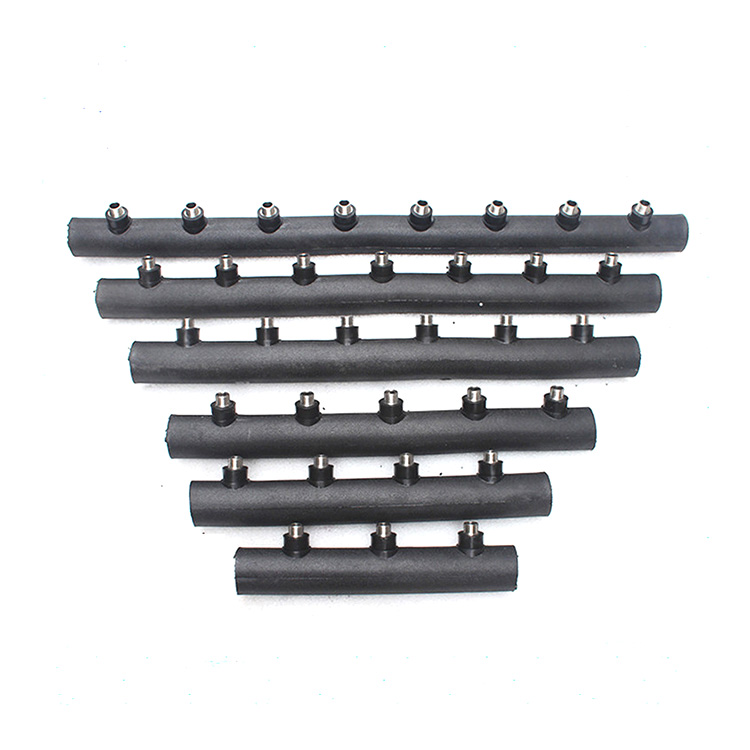HDPE 90 degree elbow butt fusion fitting produced ......
-

AddressZheJiang, China
-

Phone+86-17367068772
-

E-mail[email protected]
How does the environmental resistance of Hdpe Mainfold perform in terms of UV radiation?
The environmental resistance of HDPE manifolds to UV radiation is an important consideration for their long-term performance, particularly in outdoor applications where exposure to sunlight is a factor. Here's a detailed analysis of how HDPE performs in terms of UV resistance:
HDPE, by its natural composition, is susceptible to degradation when exposed to ultraviolet (UV) radiation over extended periods. UV rays, particularly in direct sunlight, can cause the polymer chains in HDPE to break down, leading to a process called photo-oxidation. This results in:
UV exposure can cause HDPE manifolds to develop surface cracks, making the material brittle over time.The weakening of polymer bonds reduces the structural integrity of the manifold, compromising its pressure-handling ability.Long-term UV exposure can cause the surface of HDPE to fade or yellow, though this is more of an aesthetic issue than a functional one.
To counteract UV vulnerability, manufacturers often incorporate UV stabilizers or additives during the production of HDPE manifolds. These stabilizers extend the lifespan of the material by protecting it from the harmful effects of sunlight. Key methods include:
One of the most common ways to improve UV resistance in HDPE is by adding carbon black, a pigment that absorbs and neutralizes UV radiation. HDPE pipes and manifolds treated with carbon black (typically in concentrations of 2-3%) can withstand UV exposure for significantly longer periods without degradation. In fact, black HDPE pipes are often preferred for outdoor installations because of their enhanced UV stability.
Manufacturers can also use chemical inhibitors that reduce the rate of photo-degradation. These additives work by either reflecting UV rays or dissipating the energy before it can damage the material.
When treated with UV stabilizers, HDPE manifolds are highly suited for outdoor applications and perform reliably under prolonged exposure to sunlight. In such cases, they exhibit:
With appropriate UV protection, HDPE manifolds can last decades (often up to 50 years) even in outdoor settings. This is especially important in water or gas distribution systems that may be installed above ground or exposed to the elements.

UV-stabilized HDPE manifolds resist the surface cracking and brittleness that typically result from prolonged sunlight exposure.Maintenance Reduction: Due to their increased durability, UV-stabilized HDPE manifolds require minimal maintenance compared to materials that degrade more quickly under UV radiation, such as untreated plastics or some metals.
While UV stabilization greatly enhances the environmental tolerance of HDPE manifolds, it does not make them entirely immune to UV degradation. Over a very long period (decades), even UV-stabilized HDPE may begin to show signs of wear:
The breakdown process is much slower than with untreated HDPE but may still eventually occur. This might result in superficial changes or very gradual reductions in mechanical strength.In areas with particularly intense sunlight or extreme UV exposure (such as high-altitude locations), even UV-stabilized HDPE could degrade more quickly than in more temperate climates.
HDPE with UV stabilizers outperforms many other plastics that degrade more quickly under sunlight, such as polypropylene or PVC.While metals such as steel or aluminum do not degrade due to UV exposure, they are susceptible to rust, corrosion, and other environmental factors that HDPE resists. HDPE manifolds with UV protection offer a balance between durability and environmental resistance, particularly when corrosion is also a concern.
HDPE manifolds, when untreated, are vulnerable to UV radiation, but with the addition of UV stabilizers like carbon black or chemical inhibitors, they can perform exceptionally well in outdoor environments. These enhancements significantly prolong the life of HDPE manifolds, making them a viable option for long-term use in sunlight-exposed applications. While not entirely immune to UV effects, HDPE manifolds with proper UV protection offer excellent durability,minimal maintenance needs, and reliable performance in outdoor settings.
Product Display
-

HDPE 90 degree elbow butt fusion fitting
-

HDPE 45 degree elbow butt fusion fitting
HDPE 45 degree elbow butt fusion fitting produced ......
-

HDPE 22.5 degree elbow butt fusion fitting
HDPE 22.5 degree elbow butt fusion fitting produce......
-

HDPE equal tee butt fusion fittings
HDPE equal tee butt fusion fittings produced by in......
-

HDPE reducing tee butt fusion fitting
HDPE reducing tee butt fusion fittings produced by......
-

HDPE flange adaptor butt fusion fittings
HDPE flange adaptor butt fusion fittings produced ......
-

HDPE reducer butt fusion fitting
HDPE reducer butt fusion fitting produced by injec......
-

HDPE cross butt fusion fittings
HDPE cross butt fusion fittings produced by inject......
-

HDPE end cap butt fusion fitting
Mould injection hdpe end cap butt fusion fittings ......
-

PE/PPR socket fuison welding machine
PE/PPR socket fusion welding machine brief&fea......
-

Double U HDPE ground source pump fitting
Double U HDPE Ground source pump fitting produced ......
-

PIPE clamp HDPE ground source pump fitting
PIPE CLAMP HDPE Ground source pump fitting produce......
-
.jpg?imageView2/2/format/jp2)
Single U HDPE ground source pump fitting
single U HDPE Ground source pump fitting produced ......
-

U socket HDPE Ground source pump fitting
U socket HDPE Ground source pump fitting produced ......
 English
English Español
Español русский
русский عربى
عربى



Contact Us